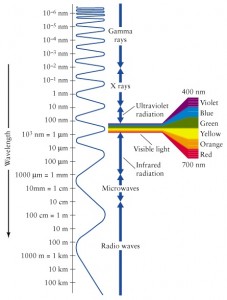Some ideas sound great (combining chocolate with peanut butter) and turn out great (Reese's Peanut Butter Cup). Some ideas sound great (getting a face lift) but turn out bad (Kenny Rogers, Greta Van Susteren). Some ideas sound bad (a Run-DMC / Aerosmith duet) but turn out great ("Walk This Way"). Some ideas sound bad (letting your daughter go camping with Levi Johnston) and turn out bad (do I really need to explain this one?). And then there are those ideas that sound terrible to begin with, and turn out even worse. Let me describe such an idea below.
Forecasting Fashion Colors - The Wavelength Time-Series Approach
When it comes to forecasting, I'm a big fan of creativity and new ideas -- the crazier the better. After failing to crack the fashion color forecasting problem while working in the apparel industry, I got to think more about the issue with the clearer head of an outsider. Is there a way to predict, a year or more in advance, what will be the "fashion" colors of future seasons? And if so, couldn't I corner the market on the dyes and fabrics, and own the fashion apparel market?
My grand idea was this:
I shall convert each fashion color from past seasons into a number -- its wavelength. Then I'll apply the usual time series forecasting methods to this time series of wavelengths, to determine the wavelengths of fashion colors for future seasons.
An idea like this might sound good after a few mushrooms, but I can't use that excuse since I haven't done drugs since 1970. The more I thought about it, the worse the idea sounded, for a number of reasons:
 Insider information, of what colors the barons of the fashion industry are planning to push on us, is probably the best way to get the color forecast for next year. Yet I lacked a ticket to Paris or Milan, or access to their private discussions.
Insider information, of what colors the barons of the fashion industry are planning to push on us, is probably the best way to get the color forecast for next year. Yet I lacked a ticket to Paris or Milan, or access to their private discussions.- There is not necessarily a single fashion color in a season, but there may be many. (For example, the Fall 2010 colors were Camel, Rich Purple, Modern Metallic, Mixed Olives, Pale Blue, and Bright Red.)
- How do I convert the name of the fashion color to a wavelength? For the regular scientific color names, I know Violet has a wavelenth of 400 nm, that Blue is 475 nm, Green is 510 nm, etc. But the fashionistas come up with all kinds of crazy names for their colors, often conjuring up images with inanimate (or animate) objects. Just in the reds we have Bright Red, Soft Red, and Medium Red, but also Fire Engine, Delicious Apple, Burning Ember, and Rusty Trombone.
The Results
Difficulties aside, I took my best shot at converting the past 25 years of fashion reds into their wavelengths, ran them through SAS Forecast Server, and came up with my forecast for Fall 2012 as 737 nm. I then went to the Pantone color wheel and realized that 737 nm is off the charts -- it is not a visible color. So either my method is wrong, or we are going to see a lot of people walking around this fall in the emperor's new clothes.
-------------------------
Wavelength image from Universe by Freedman and Kaufmann.

5 Comments
You'll potentially run into this problem whenever you predict a response variable that is confined to an interval. That's why transformations such as the logistic and probit are useful: they are "link functions" that map a bounded response onto an unbounded interval. You can then do regression on the transformed variable. Because these transformations are monotone, you can invert the link function and make inferences on the original variable.
Thank you Rick, for bringing a level of sobriety to this conversation.
For you serious analysts out there, who rely on SAS for truth and knowledge (and not just for entertaining repartee), I highly recommend Rick's blog, The DO Loop, at http://blogs.sas.com/content/iml/. In today's post you can learn all about the Cholesky Transformation, which to me is one of the top five best transformations of all time.
I like the entertaining repartee. Another possibility is that your forecast is accurate, just not the way you expect. See this video for an invisibility cloak.
http://www.youtube.com/watch?v=PD83dqSfC0Y
Dang -- you are right! I must be a genius!!!
Pingback: New blog header design by Mr. Blackwell - The Business Forecasting Deal